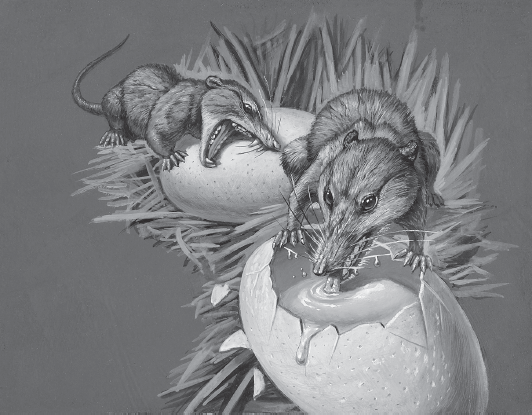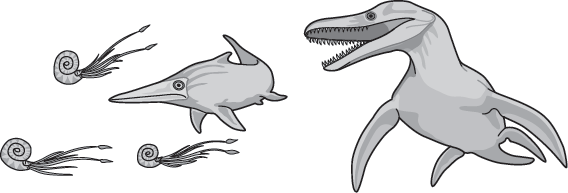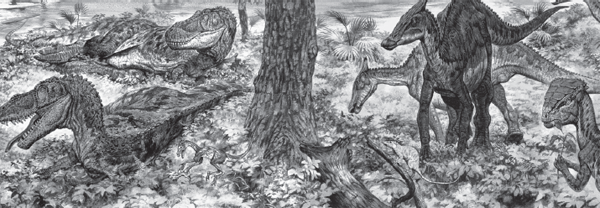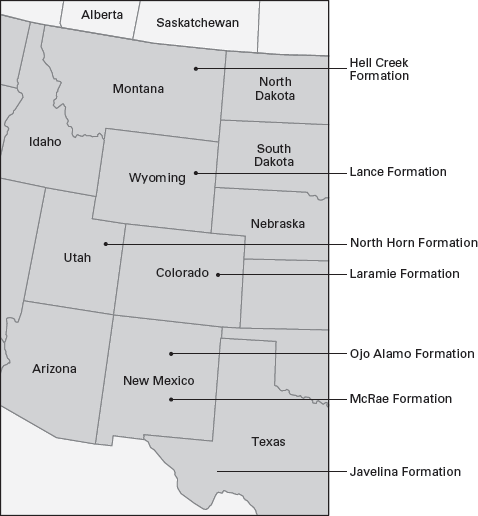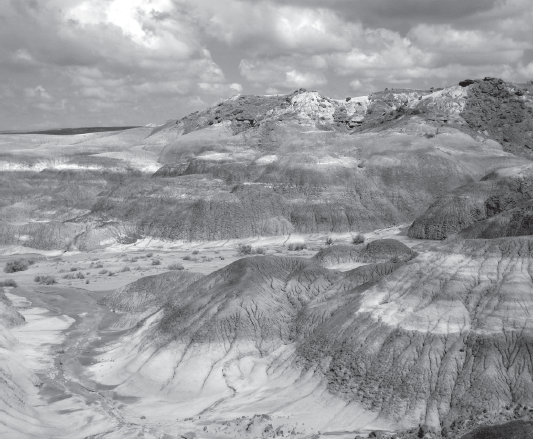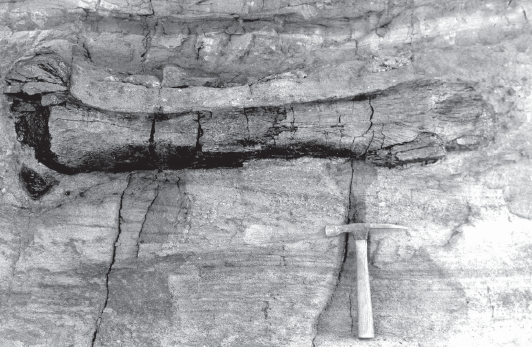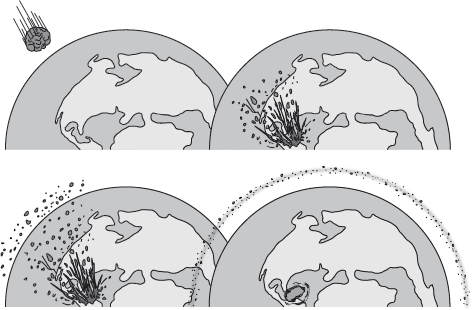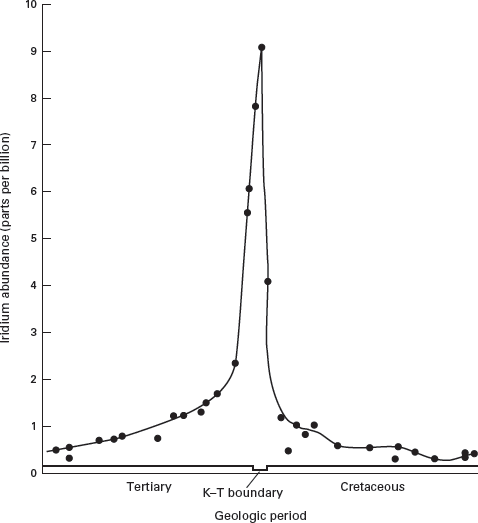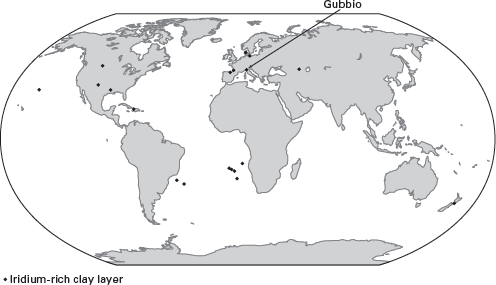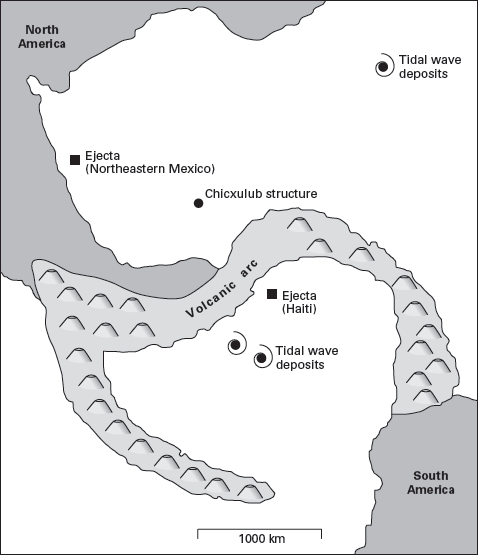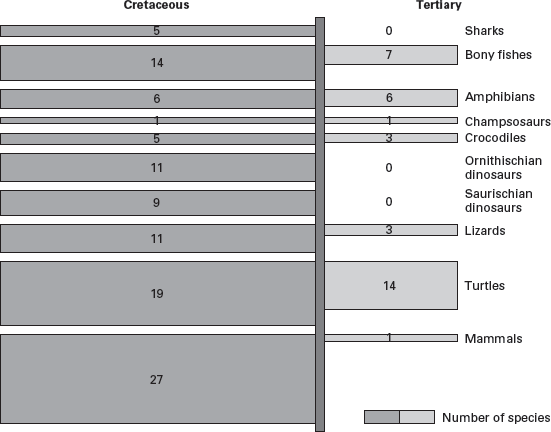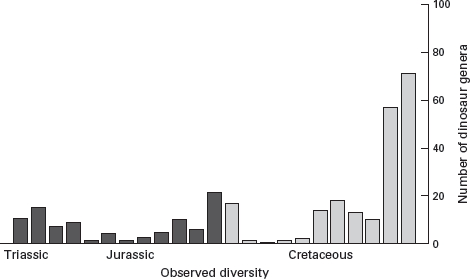THE most frequently asked question about dinosaurs is, why (or how) did they become extinct? To attempt to answer that question, we need to examine one of the most highly charged scientific debates about dinosaurs. This debate is ongoing, and it has produced two radically different explanations of dinosaur extinction. One explanation links the extinction of dinosaurs to a single cause: the impact of an asteroid that exploded upon striking the earth about 66 million years ago. The other explanation sees dinosaur extinction as due to multiple causes, including the outgrowth of changes in topography, climate, vegetation, and/or animal life because of falling sea levels and massive volcanism culminating in an asteroid impact at the end of the Cretaceous. Other explanations of dinosaur extinction, some quite well known, are based on much less (or no) evidence than these two possibilities (
box 16.1). Therefore, this chapter focuses on the two current hypotheses about the cause of dinosaur extinction.
Dinosaur extinction was part of a more pervasive extinction that occurred at the end of the Cretaceous, usually called the
terminal Cretaceous extinction, or the extinction at the Cretaceous–Tertiary boundary (or K–T boundary for short, K standing for “Cretaceous” and T for “Tertiary”). The terminal Cretaceous extinction was only one of several major extinctions in the history of life (
figure 16.1). But it was not the largest; that “honor” is held by the extinction that occurred at the end of the Permian, 251 million years ago.
The terminal Cretaceous extinction was not just the extinction of the dinosaurs. It included the extinction of several types of organisms, both in the sea and on land. Paleontologists estimate that at least 15 percent of the families (or approximately 100 families) of shelled marine invertebrates became extinct in the sea during the terminal Cretaceous extinction. Particularly hard-hit groups were the
ammonoid cephalopods, relatives of living octopuses and squids, which suffered total extinction; clams and snails, which suffered significant losses including the total extinction of the
rudists, reef-building clams, and the
inoceramids, thin-shelled, plate-like clams; and the marine reptiles, the
mosasaurs (marine lizards) and the long-necked
plesiosaurs (
figure 16.2). Major changes also occurred in the marine plankton, and the microscopic shelled protozoans known as
Foraminifera also suffered heavy losses (
figure 16.3). On land, the pterosaurs and dinosaurs became extinct, many types of
marsupial mammals disappeared, and a few types of plants died out (
figure 16.4). However, most mammals, reptiles (lizards, snakes, turtles, and crocodiles), and birds did not suffer a major extinction.
Many explanations of dinosaur extinction lack supporting evidence, but, ironically, these are some of the most widely known explanations. Perhaps the best known explanation is that dinosaurs became extinct because Late Cretaceous mammals ate their eggs (
box figure 16.1). Today, very few mammals eat eggs, humans and mongooses notwithstanding. There is no evidence of egg eating by Late Cretaceous mammals. Furthermore, mammals coexisted with dinosaurs throughout the Mesozoic reign of the dinosaurs. Why, then, would
egg-eating mammals have had an adverse effect on dinosaurs only at the end of the Cretaceous? Egg eating by mammals thus can be rejected as an explanation of dinosaur extinction.
BOX FIGURE 16.1
Mammals eating dinosaur eggs is a popular idea about the cause of dinosaur extinction for which there is no evidence. (© Mark Hallett. Reproduced with permission of Mark Hallett Paleoart)
Some explanations of dinosaur extinction rely on extreme changes in climate at the end of the Cretaceous. One argument is that dinosaurs were so large they could not hibernate and were thus unable to cope with extremely cold climates at the end of the Cretaceous. A contrasting argument is that temperatures at the end of the Cretaceous became so hot that dinosaurs literally “roasted” to death. Both of these explanations point to the small size and/or hibernating ability of the mammals and small reptiles that survived the Cretaceous as reasons why they were able to cope with one or the other temperature extreme. The problem is that there is no evidence for either an extremely hot or cold climate at the end of the Cretaceous, although the impact of an asteroid may have produced a geologically short period of intense dark and cold.
Today, some plants, called converters, absorb and concentrate radioactive elements like selenium, which are poisonous in large amounts. Large amounts of selenium are present in some volcanic ashes. Thus arose the argument that increased volcanic activity at the end of the Cretaceous produced increased selenium in plants eaten by herbivorous dinosaurs that was then passed on to the meat-eating dinosaurs when they preyed upon the plant-eaters. The theory states that the selenium poisoned the dinosaurs, bringing about their extinction. Of course, a fossil record of the selenium-converting plants does not exist, and no explanation can be offered as to why nondinosaurian plant-eaters, some mammals and nondinosaurian reptiles, were not poisoned. Selenium poisoning is an inadequate explanation of dinosaur extinction.
The longest-running extraterrestrial cause of dinosaur extinction is a supernova. It has been estimated that a nearby supernova could generate a tremendous rise in the radiation in the atmosphere, immediately killing or causing massive chromosomal mutations in the dinosaurs that would have made them sterile or at least incapable of producing viable offspring. At present, however, no remnant of a nearby 66-million-year-old supernova has been detected by astronomers. Also, the supernova explanation is hard pressed to explain why many organisms survived the Cretaceous.
Thinning of and trace elements in dinosaur eggshells at the end of the Cretaceous as a cause of dinosaur extinction was discussed in
box 12.4. There, we saw that high levels of trace elements in dinosaur eggshells may have been introduced during fossilization. Also, it has not been demonstrated that the dinosaur eggs with relatively thin shells were not viable eggs.
A similarly problematic explanation is that disease extinguished the dinosaurs. Not only is there no evidence for this, but a worldwide epidemic or plague among the dinosaurs exceeds the scope of any known disease and seems implausible.
This review of some popular, but unsupported, explanations of dinosaur extinction still leaves a residuum of fantastic ideas beyond scientific inquiry. The most popular of these is that extraterrestrial beings either hunted the dinosaurs into extinction or trapped them all and carried them off into space. Clearly, these ideas are the stuff of science fiction stories, not of the scientific inquiry into dinosaur extinction.
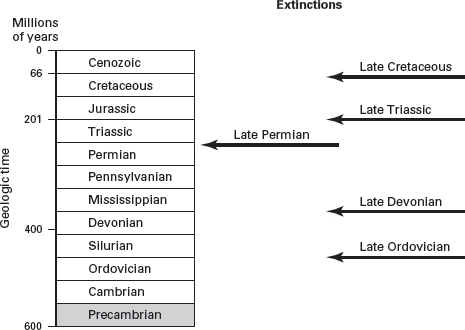
FIGURE 16.1
The terminal Cretaceous extinction was one of several major extinctions in the history of life. (Drawing by Network Graphics)
FIGURE 16.2
Several types of marine organisms became extinct at the end of the Cretaceous. Those shown here are the ammonoid cephalopods (left), the ichthyosaurs (center), and the plesiosaurs (right). (Drawing by Network Graphics)
FIGURE 16.3
Foraminifera are microscopic shelled protozoans; they suffered heavy losses during the terminal Cretaceous extinction. (Drawing by Network Graphics)
FIGURE 16.4
Dinosaurs became extinct at the end of the Cretaceous. (© Mark Hallett. Reproduced with permission of Mark Hallett Paleoart)
It is important to recognize that more than just dinosaurs became extinct at the end of the Cretaceous. The broad nature of the extinctions calls for an explanation beyond one which would account for just the disappearance of the dinosaurs. Furthermore, the selectivity of the extinctions (many types of organisms survived the Cretaceous) needs to be explained. Hence, we are looking for a cause of dinosaur extinction that is consistent with what we know about both the breadth and the selectivity of the terminal Cretaceous extinction.
We must not only consider the breadth and selectivity of the terminal Cretaceous extinction in the search for a cause, but the evidence of the extinction—the rocks and fossils and their distribution in geologic time and space—must also be considered. Indeed, the evidence takes center stage in the search for the cause of the extinction because most debate about the cause of the terminal Cretaceous extinction focuses on disagreements over the evidence and how it should be interpreted.
This issue is best understood if we make a clear, conceptual distinction between the evidence itself, or the pattern of the terminal Cretaceous extinction, and the processes that produced it. This distinction between pattern and process is a fundamental one in paleontology. It involves distinguishing the fossils themselves and the rocks that contain them as patterns to be described from the processes (for example, evolution and sedimentation) that produced the patterns. Processes can only be inferred from patterns, not observed, much as a detective might infer the process of a crime from the patterns represented by the evidence of the crime.
The pattern of the terminal Cretaceous extinction, and particularly the extinction of dinosaurs, is a subject of great disagreement among paleontologists. This disagreement lies at the core of debate over the cause of the extinction. Different patterns, especially in terms of the distributions of dinosaur fossils through geologic time, suggest different causes of extinction. One possible pattern suggests a sudden and simultaneous cause of dinosaur extinction, whereas a different pattern suggests a more gradual and long-term cause of the extinction (
figure 16.5). Which pattern best describes the fossil record of the last dinosaurs?
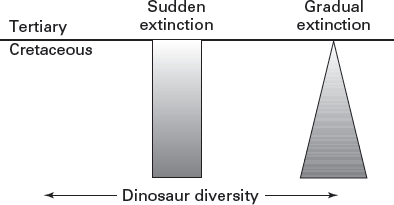
FIGURE 16.5
Two patterns of dinosaur extinction, one sudden and the other gradual, have been described. A sudden extinction is suggested by samples of dinosaur fossils that indicate unchanged dinosaur diversity until the very end of the Cretaceous. Diminishing diversity throughout the latest Cretaceous seems to be indicated by other samples (or analyses), and this is suggestive of a more gradual extinction. (Drawing by Network Graphics)
Before answering this question, let us consider another aspect of the nature of the evidence of dinosaur extinction: its completeness. The last interval of Cretaceous time is termed the
Maastrichtian, after the town of Maastricht in Belgium, and it lasted about 4 million years, from 70 to 66 million years ago. Maastrichtian dinosaurs were the last dinosaurs and are known from a variety of locations worldwide (
figure 16.6). But most of these Maastrichtian dinosaur localities are 1 million years or more older than the end of the Cretaceous and thus do not include the last dinosaurs, which are those of latest Cretaceous age. Furthermore, many of these localities yield only a few dinosaur fossils or dinosaur eggs or their fossils have not yet been collected and studied extensively.
Only late Maastrichtian dinosaur localities in western North America yield enough dinosaur fossils that have been collected and studied sufficiently to produce a detailed pattern of the distribution of the last dinosaurs in geologic time. These localities extend in an arc from the high plains of southern Alberta to the Big Bend of Texas (
figure 16.7). Although some other localities have been analyzed to explain dinosaur extinction, almost all localities that can produce a reliable pattern are restricted to a small portion of the world in western North America. This, of course, should make us cautious about the pattern of dinosaur extinction, because the pattern can be drawn from only a limited area and then assumed to represent a global pattern.
FIGURE 16.6
Maastrichtian dinosaur localities in western North America provide the only extensive record of dinosaur extinction. (Drawing by Network Graphics)
FIGURE 16.7
Maastrichtian badlands in North America, like these in northwestern New Mexico, yield the best fossil record of the last dinosaurs.
Bearing this in mind, two patterns of dinosaur extinction have been constructed from the late Maastrichtian localities in western North America. One pattern is of decreasing dinosaur abundance and diversity during the Maastrichtian; the other is of an undiminished or increasing dinosaur presence throughout the Maastrichtian (see
figure 16.5). The first pattern, of course, suggests a gradual disappearance of dinosaurs over a period of a few million years, whereas the second suggests a sudden, catastrophic extinction of the dinosaurs.
Many paleontologists believe that the first pattern accurately reflects what happened to dinosaurs at the end of the Cretaceous. But others believe that strong evidence supports the second pattern. Debate over the two patterns is ongoing, with new evidence being accumulated and described to support one pattern or the other. This makes it difficult to choose one pattern over the other at present. Instead, we can best focus our attention on how the two patterns have been arrived at and why they differ.
Documentation of how dinosaur diversity (the number of different kinds of dinosaurs) changed during the Maastrichtian is only as good as the sampling and identifications on which it is based. We need extensive collections of dinosaur fossils from as many Maastrichtian fossil layers as possible and identifications of the dinosaur fossils that are as accurate as possible (ideally including the genus and species). This might sound straightforward, but extensive collections of dinosaur fossils are expensive and time consuming. Also, many of the fossils are not complete dinosaur skeletons or skulls and thus are difficult to identify precisely (
figure 16.8).
FIGURE 16.8
Fragmentary dinosaur fossils of Maastrichtian age, such as this vertebra of a ceratopsian dinosaur from New Mexico, are difficult to identify precisely.
Different amounts of collecting, different degrees of geologic time resolution (in other words, many versus few fossil layers), and differing identifications account for the two conflicting patterns seen in the Maastrichtian dinosaurs of western North America. Also, collections from different areas, even from two nearby locations in Montana, suggest different patterns, partly because of different degrees of preservation at the different locations.
Two contrasting patterns of dinosaur extinction have thus arisen. Even a third one has been proposed that claims dinosaurs survived the Cretaceous (
box 16.2). Choosing among these patterns is critical, because each suggests a very different cause of dinosaur extinction, one gradual, the other sudden. But, as of this writing, the jury is still out on which pattern is the accurate one. Until this matter is decided, debate about dinosaur extinction will continue.
For about 150 years, paleontologists have marked the end of the Cretaceous with the disappearance of the dinosaurs. This means that the youngest dinosaur fossils are of Late Cretaceous age, and, conversely, that the discovery of a dinosaur fossil is taken to indicate the rocks at the discovery site are no younger than Late Cretaceous. Despite this, some paleontologists claim to have discovered younger dinosaur fossils, of Paleocene age, thus demonstrating that not all of the dinosaurs became extinct at the end of the Cretaceous. These claims have come from such far-flung locales as China, India, Peru, and Bolivia, as well as in from the United States, in New Mexico and Montana. If substantiated, these claims seriously challenge well-accepted ideas about the timing of dinosaur extinction.
But, most of these claims cannot be substantiated simply because the Paleocene age of the dinosaur fossils cannot be verified. This is because few of the supposed Paleocene dinosaur fossils have been found associated with other types of fossils of unquestioned Paleocene age, or directly above such fossils in the strata. A good example of this is provided by supposed Paleocene dinosaur footprints from Bolivia. These footprints are found in an exposure of a rock formation that contains no Paleocene fossils. But, many kilometers away, the same formation contains fossils of mammals and fishes of Paleocene age, so it has been suggested that the entire formation, including the dinosaur footprints, is of Paleocene age. This, despite the fact that many kilometers of forest intervene between the two exposures, so it cannot be demonstrated that the dinosaur footprints are the same age or younger than the Paleocene fishes and mammals. They might just as well be older!
A recent report of Paleocene dinosaurs from New Mexico also fails to convince because a detailed evaluation of that work shows that the claimed association of Paleocene pollen with dinosaur fossils cannot be replicated (
box figure 16.2). A lack of direct association with Paleocene fossils eliminates all but one of the current claims of Paleocene dinosaurs. This remaining claim comes from Montana, where dinosaur fossils are found in direct association, mixed in the same rock layer, with fossil mammals and pollen of Paleocene age. These dinosaur fossils are isolated teeth—mostly of hadrosaurids, ceratopsians, and small theropods—and fragments of bone. This might seem convincing proof of Paleocene dinosaurs were it not for the possibility that these dinosaurs have been reworked from older Cretaceous strata.
A fossil is said to be reworked if, after initial fossilization in the rock, it was exhumed and redeposited in an overlying, younger layer of rock. Reworking of small fossils may be common, especially in fluvial environments. Imagine, for example, isolated dinosaur teeth and parts of dinosaur bones buried and fossilized on a Late Cretaceous river floodplain. Subsequently, during the Paleocene, large river channels carve out and scour into the floodplain. In so doing, older Upper Cretaceous floodplain deposits, containing the dinosaur fossils, are eroded and carried off by the running water. This mixes the Cretaceous fossils with younger sediments and fossils, and subsequently deposits them on channel bottoms and margins, producing a mixture of Cretaceous and Paleocene fossils.
Most paleontologists believe this is the explanation of how dinosaur fossils and Paleocene mammal and pollen fossils came to be associated in Montana. They point to the small size of the dinosaur fossils and the fact that the association is in river-channel deposits as evidence that the dinosaur fossils have been reworked. But, proponents of the Paleocene age of these dinosaur fossils point to the lack of damage, abrasion, and weathering of the dinosaur teeth as evidence against their having been reworked. They argue that we should see some mechanical damage to the dinosaur teeth by the process of erosion, exhumation, transport, and reburial that reworking entails.
BOX FIGURE 16.2
This hadrosaur femur from New Mexico was found stratigraphically above fossils of Paleocene pollen. It is almost certainly a reworked fossil from underlying Cretaceous strata.
But is this really the case? Cretaceous shark teeth found reworked in rocks as young as Eocene show no evidence of mechanical damage. Therefore, we might expect reworking of dinosaur teeth to occur without appreciable alteration of the fossils.
There thus seems to be no convincing evidence for Paleocene dinosaurs. The search for them, however, continues, and we can expect claims of Paleocene dinosaurs to continue for as long as dinosaur extinction is studied.
Having revealed the impasse over the pattern of dinosaur extinction, it might seem anticlimactic to discuss possible causes. But, the two current explanations of dinosaur extinction present possible explanations of the alternative patterns, and one or the other, or a combination of both, stands a good chance of being correct.
In 1979, Nobel physics laureate Luis Alvarez, his geologist son, Walter Alvarez, and two nuclear chemists, Frank Asaro and Helen Michel, proposed that an asteroid the size of a mountain (10 kilometers in diameter) collided with Earth 66 million years ago and caused the terminal Cretaceous extinction (
figure 16.9). They based this proposition on the chemical analysis of a thin, 66-million-year-old clay layer at
Gubbio in northern Italy. This clay layer was deposited by wind-blown dust that settled at the bottom of the sea at the end of the Cretaceous, and the chemical analysis revealed it contains an unusually high concentration of the platinum-group metal
iridium (
figure 16.10). Iridium is very rare on the earth’s surface except in some rock deposits mined for gold and platinum. The rocks at Gubbio are clearly not such a deposit. Most of the iridium on Earth comes from meteorites and other matter from space, so the Alvarez team decided that the high concentration in the 66-million-year-old clay at Gubbio must have settled in the dust produced by a huge asteroid impact.
This idea elicited both criticism and enthusiasm in the scientific community, and much effort was expended in the 1980s to either refute or support the theory of the asteroid impact and its inferred results. Further chemical analysis of the Gubbio clay layer revealed it contains other elements (such as osmium) not common on Earth except as the result of meteoritic infall. The high concentration of iridium was also identified in 66-million-year-old rock layers at dozens of other localities worldwide (
figure 16.11). Another peculiarity of these layers is that they contain microscopic droplets of “
shocked quartz,” a type of quartz grain with laminar deformations known to be generated only by high-speed shock in laboratories, nuclear test sites, and near impact craters.
The search for the terminal Cretaceous impact crater also energized research into the detection of ancient impact craters on the earth’s surface (
box 16.3). This research identified about 16 impact craters that could be the right age to have been the site of the terminal Cretaceous asteroid impact. Most of these craters are in and around the Atlantic Ocean basin, and the possibility of multiple asteroid impacts at the end of the Cretaceous has also been suggested.
FIGURE 16.9
An asteroid impact at the end of the Cretaceous may have looked like this. (Drawing by Network Graphics)
FIGURE 16.10
In northern Italy, the clay layer that marks the end of the Cretaceous contains an unusually high abundance of iridium. (Drawing by Network Graphics)
At the time of this writing, the evidence that one or more asteroids struck the Earth at the end of the Cretaceous seems conclusive to most geologists and paleontologists. But, some geologists have argued that massive volcanic eruptions at the end of the Cretaceous produced the iridium-rich layer. These geologists point to huge Late Cretaceous volcanoes that were present in India, Siberia, and other locations as the source of the iridium-rich layer. This source, however, could not have provided the shocked quartz or some of the other features peculiar to the iridium layer, and for this reason most scientists discount volcanism as the likely source of the layer.
Although it now seems certain that one or more asteroids collided with Earth 66 million years ago, how and whether that would have caused the terminal Cretaceous extinction is much less certain. Initially, the Alvarez team suggested that the impact generated dust that produced global darkness, causing the extinctions. This dust would have stopped plant photosynthesis and cooled global temperatures, resulting in a deep freeze. Other possible effects of the asteroid impact include acid rain resulting from heating of the atmosphere by the entering asteroid or a worldwide greenhouse effect (after the initial deep freeze following impact) produced by water vapor that would have been lofted into the atmosphere if the asteroid landed in the ocean.
FIGURE 16.11
An iridium-rich clay layer has been identified at the Cretaceous–Tertiary boundary at many sites worldwide. (Drawing by Network Graphics)
In 1990, a group of American geologists announced the discovery of a huge impact structure of terminal Cretaceous age, and this structure has since been proclaimed the “smoking gun” behind the terminal Cretaceous extinctions. Located on the northwestern coast of Mexico’s Yucatán Peninsula, the
Chicxulub (pronounced CHICKS-uh-loob) structure is a circular collapse feature with an estimated diameter of about 180 kilometers (
box figure 16.3). Diverse and impressive evidence makes Chicxulub look like the place where a huge asteroid crashed into the earth at the end of the Cretaceous. This evidence includes the following points:
1. The Chicxulub structure itself has many features diagnostic of an impact crater, including the concentrically collapsed crust under it.
2. A layer of melted rock underlies the structure. The numerical age of this melt layer has been calculated at 66 million years, exactly the Cretaceous–Tertiary boundary. And the melted rocks are unusually rich in iridium.
3. Above the melted rocks are well-sorted debris that is most easily understood as rock fragments that fell back into the crater after the impact.
4. Tidal wave deposits of the same age as the structure have been identified in the southern Gulf of Mexico and the western Atlantic.
5. Deposits of rock debris thrown out of the crater (called ejecta) have been found in Haiti and northeastern Mexico. These deposits are full of shocked mineral grains and melted rock droplets.
BOX FIGURE 16.3
This paleogeographic map of the Caribbean at the end of the Cretaceous shows the Chicxulub impact structure (now under the seafloor) and some related rock features. (Drawing by Network Graphics)
The case for Chicxulub being the site where the asteroid plowed into Earth at the end of the Cretaceous seems incontrovertible, though some critics still argue that it predates the terminal Cretaceous extinctions by as much as 300,000 years.
At the end of the Cretaceous, much of the rock present at the site of the Chicxulub structure consisted of anhydrite, a mineral rich in sulfur. Some scientists suggest that the impact released huge amounts of sulfur into the atmosphere. The sulfur would have combined with water, producing sulfuric acid and a devastating acid rain. Acidic dust would then have filled the upper atmosphere, blocking out sunlight and causing a decade of freezing or near-freezing temperatures worldwide.
Currently, there is no clear agreement on the precise effect of the asteroid impact, but there is general agreement that it produced a
global catastrophe. Whether this catastrophe caused the terminal Cretaceous extinctions, or whether it was a violent perturbation weathered by most organisms, is still debated.
We might best think of this by concluding that the iridium-rich layer is a pattern indicative of a specific process: an asteroid impact. Now, the question becomes, does the pattern of dinosaur and other Late Cretaceous fossil distribution support the asteroid impact and the resulting catastrophe as the cause of the extinction?
One advantage of the asteroid-impact explanation is that it predicts a sudden and simultaneous pattern of terminal Cretaceous extinction. Many fossil patterns, such as those constructed by some paleontologists for Maastrichtian dinosaurs, don’t indicate a sudden and simultaneous end. But, proponents of the asteroid-impact explanation argue that these patterns are based on incomplete sampling of fossils or incomplete preservation of latest Maastrichtian fossils. There is some evidence to support their contention. For example, dinosaur collecting by paleontologist Peter Sheehan and colleagues of the Milwaukee Public Museum in eastern Montana and western North Dakota has been interpreted to reveal no evidence of a gradual decline of dinosaurs at the end of the Cretaceous. In contrast, other intensively sampled locations suggest gradual decline and an ecological collapse of dinosaurs during the Maastrichtian. One of these studies represents the most serious challenge to the sudden, catastrophic extinction of dinosaurs posited by the asteroid-impact explanation.
The badlands developed in the upper Maastrichtian and Paleocene strata in eastern Montana represent the most extensively sampled record of dinosaur extinction on Earth. The upper Maastrichtian rocks are the Hell Creek Formation overlain by lower Paleocene strata of the Tullock Formation. The end of the Cretaceous, and the boundary of the two formations, has generally been placed at a layer of coal called the Z-coal bed. An iridium-rich layer is found just below this coal bed.
Beginning in the 1950s, paleontologists William Clemens of the University of California at Berkeley and Robert Sloan of the University of Minnesota, as well as numerous colleagues and students, collected fossils from these rocks. This collecting has produced an unparalleled record of the evolution of terrestrial plants and animals during the transition from the Cretaceous to the Tertiary.
Much of this record does not suggest a sudden, catastrophic extinction at the end of the Cretaceous (
figure 16.12). For example, there is evidence that placental mammals increased in diversity throughout the Maastrichtian. Nondinosaurian reptiles, including lizards, snakes, turtles, and crocodiles, show very little extinction at the end of the Cretaceous, with only about 30 percent of their genera disappearing. Dinosaurs do go extinct at the end of the Cretaceous, but there was a marked decline in diversity in the Hell Creek Formation from 19 genera at its base, to 12 in the upper 16 meters of the formation to 7 at the very top.
FIGURE 16.12
The fossil record of vertebrates from the Hell Creek Formation shows some groups diversifying before, and most groups surviving, the end of the Cretaceous. (Drawing by Network Graphics)
This pattern of dinosaur decline is either real or an artifact of sampling and biases in preservation. If real, it presents the strongest evidence available of a gradual extinction of dinosaurs during the late Maastrichtian. This evidence, and other patterns of fossil distribution, certainly do not support the sudden extinction predicted by the asteroid-impact explanation. Instead, they suggest complicated ecological factors as a likely cause of dinosaur extinction.
These ecological factors might include cooling and drying of climate because of a worldwide drop in sea level at the end of the Cretaceous, changes in vegetation due to the climate change, changes in topography and land bridges created by the sea level fall, and/or competition from diversifying placental mammals who might have posed a real problem for small, juvenile dinosaurs. Extensive volcanism during the latest Cretaceous, particularly in the Deccan Traps of India, also may have altered climate, ocean chemistry, and other aspects of marine and terrestrial environments. Indeed, Deccan was such a huge volcanic field that the lava it extruded would cover an area from Alaska to Texas to a depth of 610 meters. The result would have been a complex ecological collapse of the global ecosystem during the last few million years of the Cretaceous. This could have caused many of the extinctions, culminating in a “really bad day” for the dinosaurs when the asteroid struck.
Certainly, such possibilities don’t present a cause of dinosaur extinction as simple, and therefore as appealing, as an asteroid impact. But, the pattern of dinosaur extinction and other fossil distributions in the Hell Creek Formation suggest to many paleontologists a complex, ecological cause of dinosaur disappearance.
A number of paleontologists have questioned the significance of dinosaur extinction. This questioning has taken three approaches.
The first approach has been to point out that the significance of the entire terminal Cretaceous extinction has been greatly overstated. Today, most of the living species of animals are arthropods and worms that lack fossilizable skeletal parts. There is no reason to believe that these animals did not have a similar diversity during the Late Cretaceous, yet they left no fossils during that interval of geologic time. This means, of course, that paleontologists have virtually no idea how, if at all, these soft-bodied animals were affected by the terminal Cretaceous extinction. This should lower our confidence in estimates of the magnitude of the terminal Cretaceous extinction. These estimates, which range from a kill of from 40 to 80 percent of the species on Earth, apply only to those organisms with fossil records and thus may greatly overstate the magnitude of the terminal Cretaceous extinction.
This is a valuable perspective on the terminal Cretaceous extinction, or for that matter, any extinction being studied in the fossil record. We should always remember that the fossil record is incomplete and not interpret it as if it preserves all organisms that lived during the past. Yet, this perspective should not fundamentally alter the significance of dinosaur extinction. The dinosaur fossil record relevant to extinction is, as discussed earlier, very incomplete, yet it is good enough to demonstrate that dinosaurs did become extinct, and their extinction merits an explanation.
Or did they become extinct? The second approach to questioning the significance of dinosaur extinction is to state that dinosaurs are not extinct. They survive as birds, so what is all this fuss about their extinction? This viewpoint, however, merely dodges the issue of dinosaur extinction. The dinosaurs that became extinct at the end of the Cretaceous represented a significant group of animals. The fact that their descendants, the birds, or if you like, one group of feathered dinosaurs, survived the extinction does not diminish the significance of the terminal Cretaceous extinction of dinosaurs. Birds appeared during the Late Jurassic, long before the extinction of the dinosaurs, and it is highly likely their closest relatives among the theropod dinosaurs were extinct long before the Late Cretaceous. It is an interesting question why birds survived the Cretaceous, one that needs to be considered in any attempt to explain the terminal Cretaceous extinctions. But, the survival of birds does not diminish the significance of dinosaur extinction.
A third and final approach to questioning the significance of dinosaur extinction stems from a “long view” of the fossil record of dinosaurs. This long view points out that somewhere between 900 and 1,200 genera of dinosaurs are estimated to have lived during the Late Triassic through the Late Cretaceous (about 500 valid genera are known), most of which became extinct before the Late Cretaceous (
figure 16.13). The last dinosaurs represent only a small portion of their total Mesozoic diversity, so the extinction of dinosaurs is merely the disappearance of a relatively small fraction of the entire group.
FIGURE 16.13
Dinosaur diversity during the Late Triassic through the Late Cretaceous indicates that most dinosaurs that lived disappeared before the end of the Cretaceous. (Drawing by Network Graphics)
This argument, like the previous one, dodges the issue of dinosaur extinction. Its faults are best revealed by a terrifying analogy. Suppose the human species became extinct tomorrow. If so, it would be true that most species (and individuals) of humans became extinct before the final disappearance of Homo sapiens. Thus, like the dinosaurs, the final extinction of humankind would be the disappearance of only a small fraction of the group. But, should this minimize the significance of these final extinctions? Indeed, the final extinction of most groups of organisms involved only a fraction of the species of that group that ever lived. Dinosaur extinction thus remains a significant phenomenon, regardless of the incompleteness of the fossil record, the survival of birds, or the pre–Late Cretaceous diversity of the dinosaurs.
After all of this discussion, we are still led back to the original question: what caused the extinction of the dinosaurs? The answer to this question, as we now know, depends on which pattern of distribution of the last dinosaurs is correct. One pattern suggests a sudden and simultaneous disappearance of dinosaurs at the end of the Cretaceous and thus supports a major catastrophe, as would be caused by an asteroid impact. This is a single-cause explanation of dinosaur extinction. An alternative pattern of a gradual decline of the dinosaurs during the last 10 million years of the Cretaceous suggests that complicated ecological changes brought about dinosaur extinction. These ecological changes were followed by an asteroid impact that eliminated the last dinosaurs, thus combining the two most likely causes. This is a multiple-cause explanation of dinosaur extinction.
The inability to provide a simple answer to the question of what killed the dinosaurs may disappoint some. But, this inability reflects the fact that not all the evidence is in on dinosaur extinction. The disappearance of the dinosaur remains a vigorous field of scientific research and debate.
1. The two current, and debated, explanations of dinosaur extinction identify a single cause, an asteroid impact, or multiple causes of complex ecological changes due to sea-level fall and volcanism, culminating in an asteroid impact.
2. Other explanations of dinosaur extinction lack strong evidence and include egg-eating mammals, extreme cold or hot climates, poisoning, a supernova explosion, thinning and trace elements in dinosaur eggshells, disease, and extraterrestrial big-game hunters.
3. The terminal Cretaceous extinction eliminated many types of organisms in the sea and on the land.
4. The broad extent and selectivity of the terminal Cretaceous extinction force a search for a cause that explains both of these factors.
5. Patterns are found in the fossils and rocks studied by paleontologists. The processes (evolution and sedimentation) that created these patterns cannot be observed directly.
6. Different distribution patterns of the last dinosaurs reflect different degrees of sampling and precision of identification.
7. Strong evidence, accepted by most geologists, indicates one or more asteroids impacted the earth 66 million years ago.
8. Supporters of an asteroid impact causing dinosaur extinction propose a sudden and simultaneous extinction of dinosaurs.
9. According to some paleontologists, the pattern of fossil distribution in the Hell Creek Formation in Montana is not consistent with an asteroid impact causing the terminal Cretaceous extinction. Instead, they believe it suggests a gradual decline of dinosaurs because of complicated ecological changes.
10. Some paleontologists minimize the significance of dinosaur extinction by noting that the magnitude of the terminal Cretaceous extinction has been overstated, that dinosaurs did not become extinct because birds survived, or that the last dinosaurs represent a small fraction of all dinosaurs that ever lived. These arguments, however, do not diminish the importance of dinosaur extinction.
11. The inability to give a simple answer to the question of what caused dinosaur extinction reflects the fact that all the data are not in on the subject.
ammonoid
Chicxulub
ecological collapse
egg-eating mammals
ejecta
Foraminifera
global catastrophe
Gubbio
Hell Creek Formation
inoceramid
iridium
Maastrichtian
Montana
mosasaur
multiple cause
pattern
plesiosaur
process
reworked
rudist
selenium
shocked quartz
single cause
supernova
terminal Cretaceous extinction
1. What are some popular ideas about the cause of dinosaur extinction, and why are they not accepted by most paleontologists?
2. Describe the extent of the terminal Cretaceous extinction.
3. How do the extent and selectivity of the terminal Cretaceous extinction affect attempts to determine its cause?
4. Distinguish a pattern from a process, and explain how these concepts apply to paleontology.
5. How does the nature of the fossil record of Maastrichtian dinosaurs influence our understanding of dinosaur extinction?
6. Why are there two contrasting patterns of dinosaur extinction described by paleontologists?
7. What evidence indicates an asteroid impact with the earth 66 million years ago? What would be some of the possible effects of such an impact?
8. Did an asteroid impact cause the extinction of the dinosaurs?
9. What does the fossil record from the Hell Creek Formation in Montana suggest about dinosaur extinction?
10. How have some paleontologists minimized the significance of the extinction of dinosaurs, and what are the strengths and weaknesses of their arguments?
11. What killed the dinosaurs? Defend your answer.
Archibald, J. D. 1996. Dinosaur Extinction and the End of an Era: What the Fossils Say. New York: Columbia University Press. (A complete review of the terminal Cretaceous extinction by a proponent of multiple causes)
Archibald, J. D. 2013. The end-Cretaceous extinction, pp. 497–512, in N. MacLeod, J. D. Archibald, and P. S. Levin, eds., Grzimek’s Animal Life Encyclopedia. Vol. 2, Extinction. Detroit: Gale Cengage Learning. (A very even-handed review of the terminal Cretaceous extinctions and possible causes)
Benton, M. J. 1990. Scientific methodologies in collision: The history of the study of the extinction of the dinosaur. Evolutionary Biology 24:371–400. (Reviews the history of ideas about dinosaur extinction)
Brusatte, S. L., et al. 2015. The extinction of the dinosaurs. Biological Reviews 90:628–642. (Argues for there not being a long-term decline in dinosaur diversity prior to their extinction)
Fassett, J. E. 2009. New geochronologic and stratigraphic evidence confirms the Paleocene age of the dinosaur-bearing Ojo Alamo Sandstone and Animas Formation in the San Juan Basin, New Mexico and Colorado.
Palaeontologia Electronica 12:1–146. (Recent claim of Paleocene dinosaurs from New Mexico)
Fastovsky, D. E., et al. 2004. Shape of Mesozoic dinosaur richness. Geology 32:877–880. (Reviews all Mesozoic dinosaur diversity to argue that it was increasing just prior to their extinction)
Hartman, J. H., K. R. Johnson, and D. J. Nichols, eds. 2002. The Hell Creek Formation and the Cretaceous-Tertiary Boundary in the Northern Great Plains. Geological Society of America, Special Paper 361. (Compendium of 19 articles on the world’s best record of dinosaur extinction)
Lucas, S. G., et al. 2009. No definitive evidence of Paleocene dinosaurs in the San Juan Basin. Palaeontologia Electronica 12:1–10. (Critique of Fassett’s 2009 claim of Paleocene dinosaurs from New Mexico)
Rigby, J. K., Jr. 1987. The last of the North American dinosaurs, pp. 119–135, in S. J. Czerkas and E. C. Olson, eds., Dinosaurs Past and Present. Vol. 2. Los Angeles: Natural History Museum of Los Angeles County and University of Washington Press. (Presents some of the basis for the claim of Paleocene dinosaurs in Montana)
